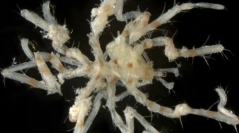

 European Journal of Taxonomy
2017 (286) - Pages 1-33 (EJT-286)
European Journal of Taxonomy
2017 (286) - Pages 1-33 (EJT-286)The family Ammotheidae is the most diversified group of the class Pycnogonida, with 297 species described in 20 genera. Its monophyly and intergeneric relationships have been highly debated in previous studies. Here, we investigated the phylogeny of Ammotheidae using specimens from poorly studied areas. We sequenced the mitochondrial gene encoding the first subunit of cytochrome c oxidase (CO1) from 104 specimens. The complete nuclear 18S rRNA gene was sequenced from a selection of 80 taxa to provide further phylogenetic signal. The base composition in CO1 shows a higher heterogeneity in Ammotheidae than in other families, which may explain their apparent polyphyly in the CO1 tree. Although deeper nodes of the tree receive no statistical support, Ammotheidae was found to be monophyletic and divided into two clades, here defined as distinct subfamilies: Achelinae comprises the genera Achelia Hodge, 1864, Ammothella Verrill, 1900, Nymphopsis Haswell, 1884 and Tanystylum Miers, 1879; and Ammotheinae includes the genera Ammothea Leach, 1814, Acheliana Arnaud, 1971, Cilunculus Loman, 1908, Sericosura Fry & Hedgpeth, 1969 and also Teratonotum gen. nov., including so far only the type species Ammothella stauromata Child, 1982. The species Cilunculus gracilis Nakamura & Child, 1991 is reassigned to Ammothella, forming the binomen Ammothella gracilis (Nakamura & Child, 1991) comb. nov. Additional taxonomic re-arrangements are suggested for the genera Achelia, Acheliana, Ammothella and Cilunculus.
Pantopoda, taxonomy, DNA phylogeny, barcode of life, strand-bias.